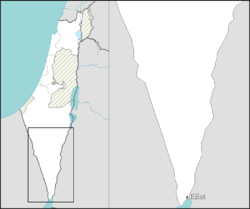Mitzpe Ramon
Mitzpe Ramon
|
||
|---|---|---|
| Hebrew transcription(s) | ||
| • ISO 259 | Miçpe Ramon | |

Neighborhood overlooking Ramon Crater
|
||
|
||
| Coordinates: 30°36′29″N 34°48′11″E / 30.608°N 34.803°ECoordinates: 30°36′29″N 34°48′11″E / 30.608°N 34.803°E | ||
| District | Southern | |
| Founded | 1951 | |
| Government | ||
| • Type | Local council | |
| • Head of Municipality | Roni Marom | |
| Area | ||
| • Total | 62,875 dunams (62.875 km2 or 24.276 sq mi) | |
| Elevation | 839 m (2,753 ft) | |
| Population (2015) | ||
| • Total | 4,998 | |
| Website | www.mitzpe-ramon.muni.il | |
Mitzpe Ramon (Hebrew: מִצְפֵּה רָמוֹן, lit. Ramon Lookout; Arabic: متسبي رمون) is a town in the Negev desert of southern Israel. The name Ramon comes from the Hebrew "Romai" meaning Romans. It is situated on the northern ridge at an elevation of 860 meters (2,800 feet) overlooking a sizable erosion cirque known as the Ramon Crater. In 2015 it had a population of 4,998.
Mitzpe Ramon was founded in 1951 as a camp for the workers building the road to Eilat. The town's first permanent residents, immigrants from North Africa and Romania, settled there in the 1960s, and it became the southernmost of the Negev's development towns. The previous mayor, Flora Shoshan, sister of former Israeli defense minister Amir Peretz and wife of the former mayor, Sami Shoshan, was voted out on October 23, 2013 and replaced by Roni Marom in a landslide win.
Several young families came from Kibbutz Reim and other parts of Israel around 1956–57. There was an influx of immigrants from Morocco and India in the early 1960s. Conditions in the early years were harsh, with limited food supplies and practically no modern day amenities. Ice blocks and provisions were delivered once a week by a supply truck. There was a single school with one classroom for all ages. The homes of the first settlers were prefabricated asbestos barracks. Later, rows of small attached stone houses were built and after that, apartment buildings, beginning in the early 1960s.
Ramon Crater, known as a makhtesh, is 38 km long, 6 km wide and 450 meters deep.
Mitzpe Ramon's climate borders between hot desert climate and cold desert climate (Köppen climate classification: BWh/BWk), characterized by hot, dry summers and cold winters. There are moderate to strong winds all year long, caused by its location above the crater, which make Mitzpe Ramon feel much colder than it really is. Precipitation is scarce, concentrated around the winter months, with an annual precipitation amount of roughly 70 millimeters (2.75 inches). Snowfall occurs on average once in a couple of years.
...
Wikipedia


